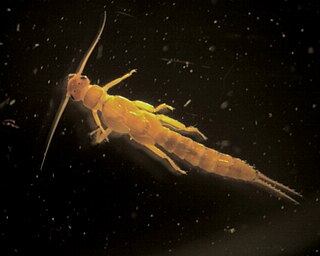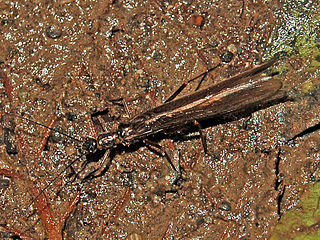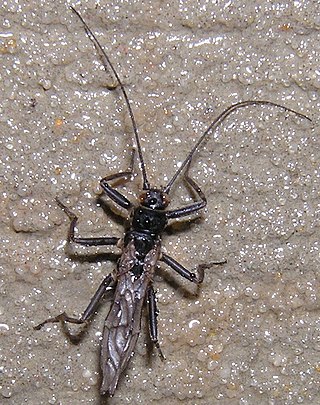
Taeniopterygidae are a family of stone flies with about 110 described extant species. They are commonly called willowflies or winter stoneflies and have a holarctic distribution. Adults are usually smaller than 15 mm.

The Peltoperlidae, also known as roach-like stoneflies or roachflies, are a family of stoneflies.

The Perlidae are a family of stoneflies, with more than 50 genera and 1,100 described species. The majority of the Perlidae are found in eastern North America, but they occur worldwide except for Antarctica and parts of Africa. Their lifecycles range between one and three years. They adults emerge in the summer; they are very active and known to be attracted to light sources. They are usually very sensitive to changes in environment.

The Capniidae, the small winter stoneflies, are a family of insects in the stonefly order (Plecoptera). It constitutes one of the largest stonefly families, containing some 300 species distributed throughout the holarctic. Their closest relatives are the rolled-winged stoneflies (Leuctridae).

Arctoperlaria is a suborder of stoneflies, with a World-wide distribution. The Plecoptera Species File divides this suborder as follows:

Chloroperlidae are a family of stoneflies, commonly known as green stoneflies, with more than 200 species and 22 genera. They appear green to yellow in colour, and are popularly used among fisherman as bait for trout fishing. Green stoneflies live in the benthic zone of the cold streams and rivers of five continents and four zoogeographical regions, emerging from the water to live in the riparian zone as adults. They are sensitive to pollutants, making them an indicator species for determining the quality of water bodies. Chloroperlidae are hemimetabolous, having no pupal stage, but instead hatch from eggs as nymphs and mature directly into adults. They are omnivorous, feeding on small organisms and plant particles, and become more carnivorous as they mature. The classification of Chloroperlidae is contested, with some believing that they should be considered as members of different orders, as opposed to the order Plecoptera that they currently belong to.

Isoperla is a genus of Palaearctic and Nearctic stoneflies in the subfamily Isoperlinae and the family Perlodidae.

Isoperlinae is a subfamily of Palaearctic and Nearctic stoneflies in the family Perlodidae, also known as stripetails or springflies.

The Leuctridae are a family of stoneflies. They are known commonly as rolled-winged stoneflies and needleflies. This family contains at least 390 species.

Perlodinae is a subfamily of springflies in the family Perlodidae.

Paragnetina is a genus of common stoneflies in the family Perlidae. There are at least 20 described species in Paragnetina.

Acroneuriinae is a subfamily of common stoneflies in the family Perlidae. There are about 32 genera and about 520 described species in Acroneuriinae.

Perlodini is a tribe of Palaearctic and Nearctic stoneflies in the family Perlodidae. There are more than 80 described species in Perlodini.
Cultus is a genus of stoneflies in the family Perlodidae. There are about five described species in Cultus.

Diploperlini is a tribe of springflies in the family Perlodidae. There are about 13 genera and more than 30 described species in Diploperlini.

Sweltsa is a genus of green stoneflies in the family Chloroperlidae. There are more than 50 described species in Sweltsa.

Oemopteryx is a genus of winter stoneflies in the family Taeniopterygidae. There are about six described species in Oemopteryx.

Malirekus is a genus of springflies in the family Perlodidae. There are at least two described species in Malirekus.
Megarcys is a genus of springflies in the family Perlodidae. There are about 11 described species in Megarcys.
Arcynopterygini is a tribe of springflies in the family Perlodidae. There are about 11 genera and more than 30 described species in Arcynopterygini.

















